The fight to gain top spots on Search Engine Results Page (SERP) rankings is a brutal one – albeit well worth the attempt. Even in the digital world, it’s a numbers game. Taking aggregate conversion rates into account, the more eyeballs you get, the larger your profit.
Yet even if you encounter some measure of success, the Search Engine Optimization (SEO) game is a never ending one. New technologies, shifting usage patterns, and even changing business models mean that search engines constantly evolve.
One good example that showcases the leap forward of search interpretation is Google RankBrain, introduced in 2015. It was an addition to Google’s search ranking algorithm that leveraged Machine Learning (ML) to adaptively deliver the most accurate (and relevant) search results possible.
This “smart” addition has since expanded to cover image search and now includes other components such as Natural Language Processing (NPL) filters. The latter helps offer advanced features like the ability to contextualize search queries.
Since Google has its tentacles in so many areas, the thing it lacks the least is data. Information sharing across Google platforms such as Gmail, Google Maps, Google Search, and many others enables it to customize the search experience for individual users.
While all of this is certainly interesting, the key takeaway here is that we can’t take the same brute force approach to SEO as we’ve done in the past. While you may be able to skate past in some areas (for now), some core pillars are already unavoidable.
What is SEO
SEO is the art of building websites and content that rank well on search results. It covers many areas, from website design to the exact keywords or phrases embedded within the content created. To meet the demand of search engines, we need to be able to understand how they work.
Search engines today are brilliant. They need to be since they’re matching more than three billion search queries daily with the content of every single page that’s online. If you want your content to rank well, you need to understand semantic search.
Here are the three main areas you need to pay the greatest attention to detail in when doing SEO today.
1. Semantic Search
Semantics is the study of what words and phrases (or even topics) mean. While this generally applies to languages, there is little doubt that the art of search today is of sufficient scope to have comparative needs in interpretation.
What is Semantic Search?
Semantic search is how search engines use a combination of factors to deliver the most accurate results to their users. Instead of directly passing on search terms, the search engines factor in “human” consideration such as topic, sentiment, and intent.
If the above sounds a little confusing, there’s a more straightforward way to interpret semantic search. It’s how search engines think like humans to deliver results that are as relevant as possible.
A straightforward example of this is topic categorization: search engines have to sort information into distinct categories. If we take that a step further, it would include some context based on supporting query data.
Consider the phrases “Steve Jobs founded Apple” versus “Steve Jobs ate an apple.” They may be groups of similar words, but when combined, the semantics are a world apart. It is this semantic distinction that search engines today aim to meet.
Taking that to a more advanced level, we can see that search engines aim for sentiment analysis. By being able to process semantics at higher levels, search engines can recognize the actual intent of the search query.
Intent Classification
In the case of semantic search, “intent” refers to what the user is trying to do with the search query. This understanding is fundamental to meeting SEO goals for content. Being able to interpret intent accurately is also essential to improving user experience (UX).
We can break search intent down into four distinctly recognizable categories;
- Informational
- Navigational
- Transactional intent
- Commercial
Informational intent is when someone is looking for information. We can quite clearly see this intent through terms such as “who” and “how.” It covers both very specific questions as well as those who seek to understand a broader topic.
Navigational intent is more direct since it shows that users simply want online directions. For example, if you don’t know the website’s address, simply typing in the website name will likely generate the correct destination for you.
Transactional intent is the most highly coveted segment. In the case of users who are ready to purchase something, meeting transactional intent will likely deliver traffic with the potential for higher conversion rates.
Commercial intent shouldn’t be confused with transactional intent. Rather than buyers who are ready to spend, commercial intent indicates they’re in an investigative mode. Content that meets this criterion is beneficial for affiliate websites since cookies can help them retain sales links for extended periods.
SEO Implications of Semantic Search
Knowing how search engines classify the categories of information brings us closer to meeting the demands for top ranking. We can work towards this along several core channels;
- Intent matching
- Schema markup
- Content planning
1. Intent Matching to Meet Core Requirements
Understanding intent will help you build the right content and content plan to work how search engines want it to – accurately meeting searchers’ needs. If your content can do that, it is more likely to get recommended as the correct search terms come up.
To better understand this, let’s take the case of two searches as an example; “What is SEO?” versus “Best SEO Tools.”
The first search phrase, “What is SEO,” falls cleanly into the informational intent category based on the “What is” term used. The latter indicates that there is a desire to compare products in preparation for a future purchase.
Other examples of keywords that help in intend identification include;
- Who is
- Why is
- How to
- Sale
2. Schema Markup as an SEO Booster
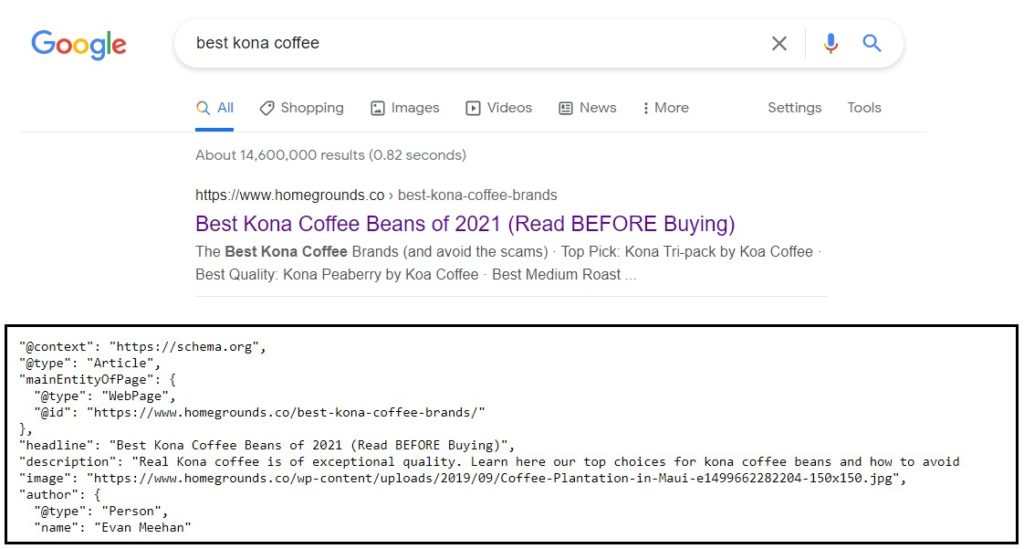
Caption: Schema markups help search engines more easily see the more relevant segments of a page.
Search engines scan through the content of web pages as it indexes them, and schema markups help show content structure. You can help Google understand your content better by using correct schema markups.
A stronger understanding of content leads to improved categorical quality scores and possibly enhanced displays of your content on search result pages. Both elements are essential to getting more search traffic directed to your website.
Schema markup isn’t complicated; it is simply a few lines of code added to the relevant content areas to define the section it presides over clearly. Aside from indicating content segment type, schema markups can also help you control how search engines present the information found in search results.
As an example of this, we can consider the “review” schema markup often used on product review pages. There are long lists of properties you can use for various schemas. All you have to do is pick the relevant ones to use.
3. Content Planning to Deliver on Expectations
Now that we’ve covered the more advanced aspects of semantic search, it’s time to take a step back and consider how to plan our content for the best exposure. We can make use of Google to help us deliver on these expectations more accurately.
Let’s consider the use of Google Image Search as one means to this end;
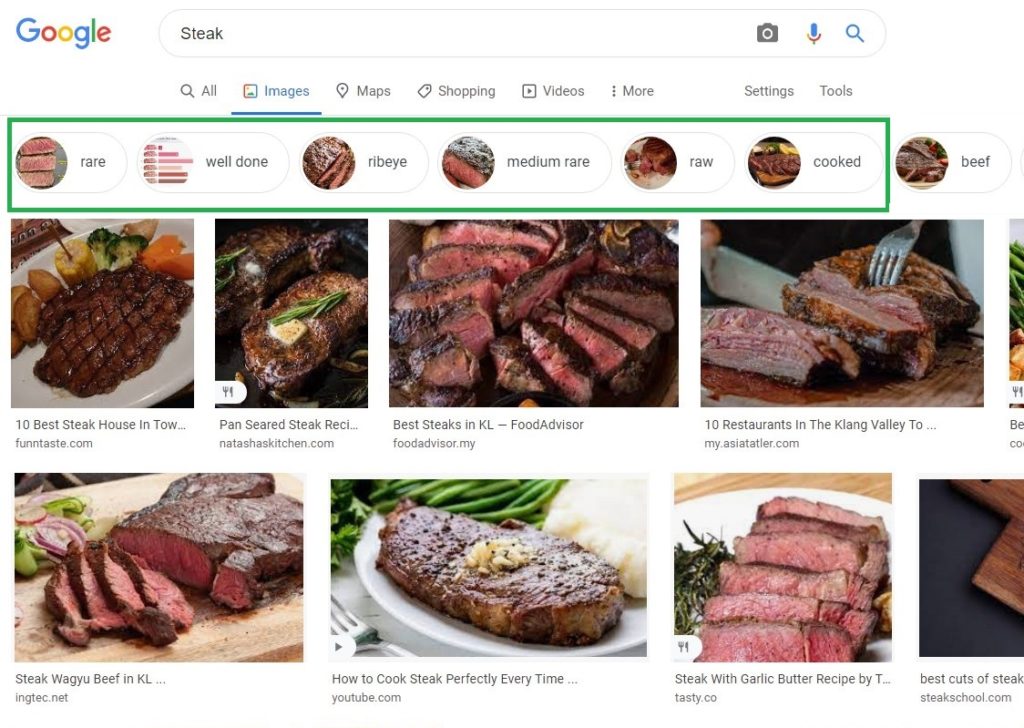
Caption: Building a recipe site? You can use steak doneness to categorize your content.
In this illustration, we’ve run a “Steak” search query through Google Image Search. At the top of the results page, we can see a range of associative words the search algorithm has “thought of” as suggestions.
Google uses semantic data to connect concepts and ideas, which combine to understand websites better contribute towards building the Google Knowledge Graph. Observing how Google sorts information and learning from Google Knowledge Graph help us understand how entities are defined and interconnected.
We can use precious information to design our website architecture and plan for our site content.
Semantics Roundup
Given how search algorithms have changed, you must keep in mind the importance of association for your content. Don’t forget that you aren’t striving simply to produce content, but content that can stand up against potentially thousands of similar nature.
Understanding semantics enables us to develop a content strategy that will rise to the top of search queries – if done accurately. While there are many fine-line items in this strategy, four core objectives are identifiable and must be met.
Content that is easily understood has greater value than simply benefiting readers. It helps search engines interpret the content more easily and deliver it to the right audience. Aside from your content, semantics also places relevance on association.
While backlink strength is a crucial consideration in domain authority, linking to relevant content is essential for semantics.
2. Keyword Research
Understanding user intent is necessary but still is only part of the overall search strategy. Another aspect of the equation lies in identifying the right keywords to target. Given the high competition for these prized words, choosing the combination that works best can be challenging.
Picking the best ones to go after could mean the difference between success and kicking a steel plate.
What is Keyword Research?
Simplistically, keyword research is the groundwork you put into finding keywords that offer you the highest potential for search traffic. This process can be slightly complex since various factors can easily skew the keyword potential.
The most straightforward way of understanding keyword research is to think of it as a supply-demand factor. Keyword or keyphrase effectiveness depends heavily on how many people use it (demand) and how many websites can fulfill it (supply).
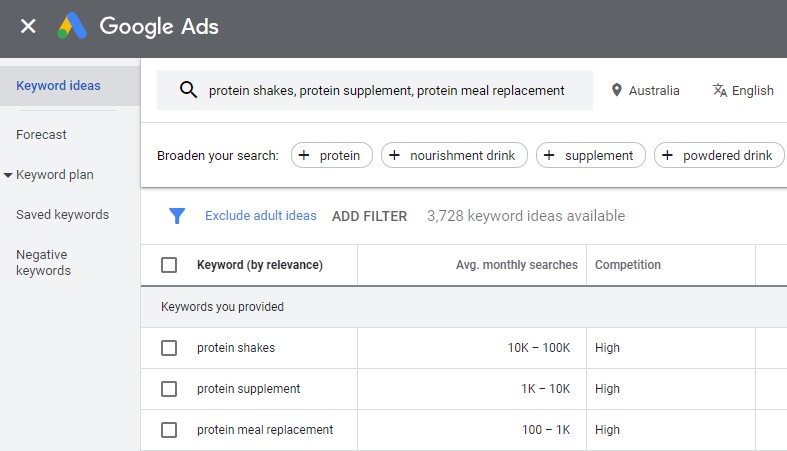
Caption: Using the Google Keyword Planner, we can see how often the term “protein shakes” is searched for over the past 12 months in Australia.
Keyword research isn’t just to help you target organic traffic but can also serve as market indicators. For instance, businesses can capitalize on rising interest to improve product strategies.
But that is not all.
While finding highly-demand keywords is essential, it is also equally important to determine what’s relevant to a keyword (and build content around it). In one of Google’s Patent filings and what we learned from Bill Slawski’s article, we know that Google may rank some results based on categorical quality.
Slawski’s article notes topicality clarifies topicality scores as;
“A score might be determined that measures how topical the resource is for the query. This could be done a few different ways, such as:
- The similarity of query terms to terms in the resources can be determined, and the more similar the terms of the query to the terms of the resource, the higher the topicality score.
- The performance of search results that reference the resource when provided in response to the query can be determined. The higher the performance (e.g., selection rate), the higher the topicality score.”
Traditional keyword research tools that focus on supply-demand and specific keywords are no longer sufficient.
If you are building an eCommerce site to sell protein shakes, it’s not enough to simply collate all the best information about the topic to rank for the query. Your site will also need to cover several other relevant topics, such as different exercises to lose weight (assuming that is the primary goal of your target audience) or even the right tumbler to use.
When researching keywords today – we need to reach deep and wide to cover all the relevant topics.
How to Conduct Your Keyword Research
Understanding the supply-demand scenario, we can work towards both ends. For demand, we need to know what people want. Thankfully, there are many sources for data such as this – Google Trends, for instance.
Let’s illustrate this with an example;
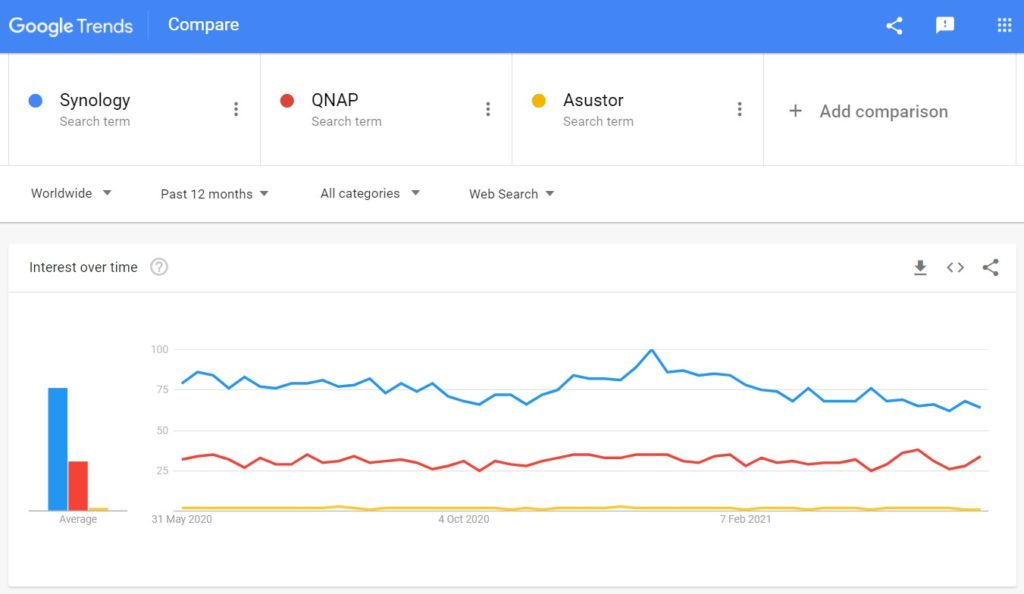
Caption: Search trends can be a strong indicator of interest in certain products or services.
If your company is selling computer hardware, you can use Google Trends to put your finger on the pulse of the Internet. If you are interested in selling Network Attached Storage devices, input top brands into Google Trends to see which is in greatest demand.
By feeding the terms “Synology,” “QNAP, and “Asustor” into Google Trends, we can see more substantial global interest in the Synology brand. You can also adjust the query for specific regions to cater to demand from local markets.
Another way to use Google Trends is to look past the “product” or “brand” focus and towards the strategic layer. For instance, consider seasonal or geopolitical trends to help you consider market sentiment.
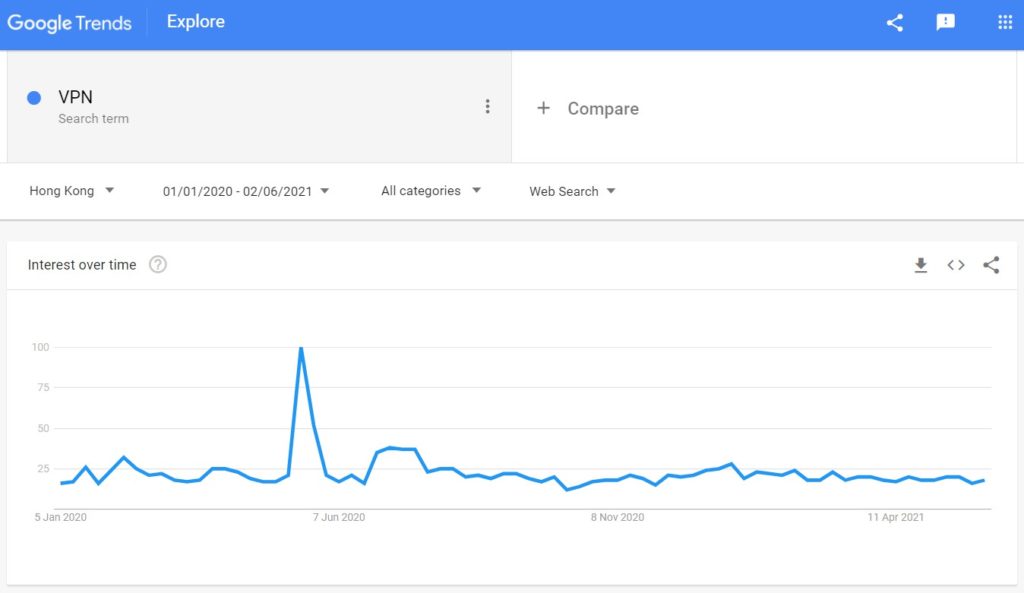
Caption: Search for “VPN” in Hong Kong spiked with new national security laws in 2020.
We can showcase one example of how beneficial this can be with the increased search demand for Virtual Private Networks (VPNs) in Hong Kong national security laws introduced in mid-2020.
Looking at these trends also gives us a better understanding of the context behind the searches.
SEO Implications for Keyword Research
However, while the “supply and demand” concept meets fundamental theory, it isn’t perfect – which is where context applies. Matching demand effectively requires proper context to the right keywords – informational, navigational, commercial, or transactional.
While Google Trends is an excellent first-line tool that can show demand, some tools can better showcase keyword and intent matching. Here are some ideas of the tools you can use;
1. KeywordTool.io
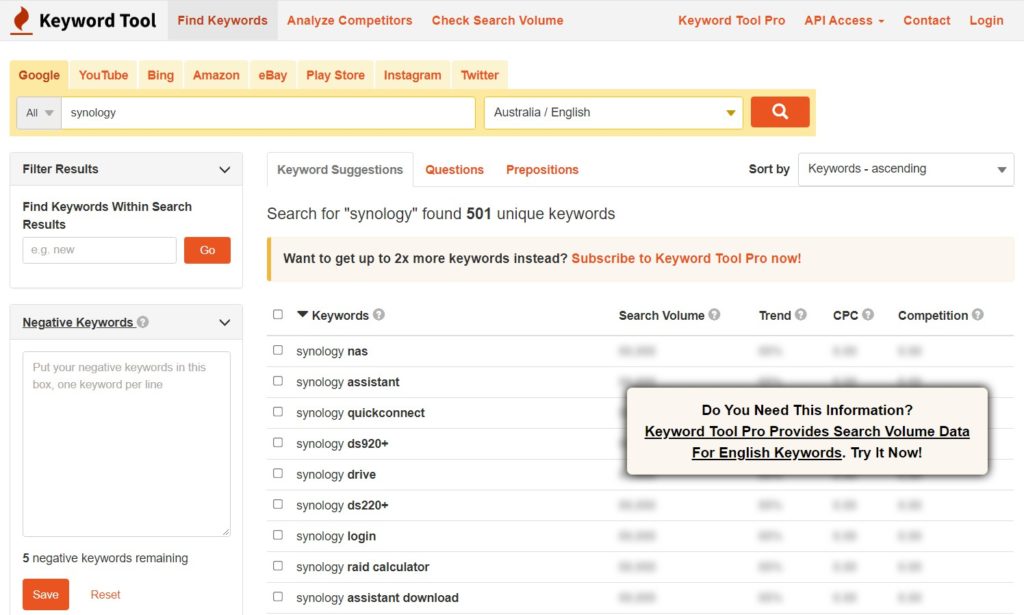
KeywordTool.io Features
- Comprehensive keyword data
- Region matching
- API for data extraction
Keyword Tool is very aptly named since it can meet multiple facets of keyword research demand. It doesn’t just show you general demand for the search term but more comprehensive data that uses Google Autocomplete data for keyword generation.
This data includes other keywords associated with your query, along with average search volumes, trends to indicate rising or waning demand, value, and a competitive index to show how hotly contested the keywords are.
The overall concept of Keyword Tool fits in very precisely with the interpretive nature of Google Search that we’ve been covering thus far. In addition, there’s nothing better than getting information from the horses’ mouths.
Price: Free / Pro from $159 per month.
2. Answer the Public
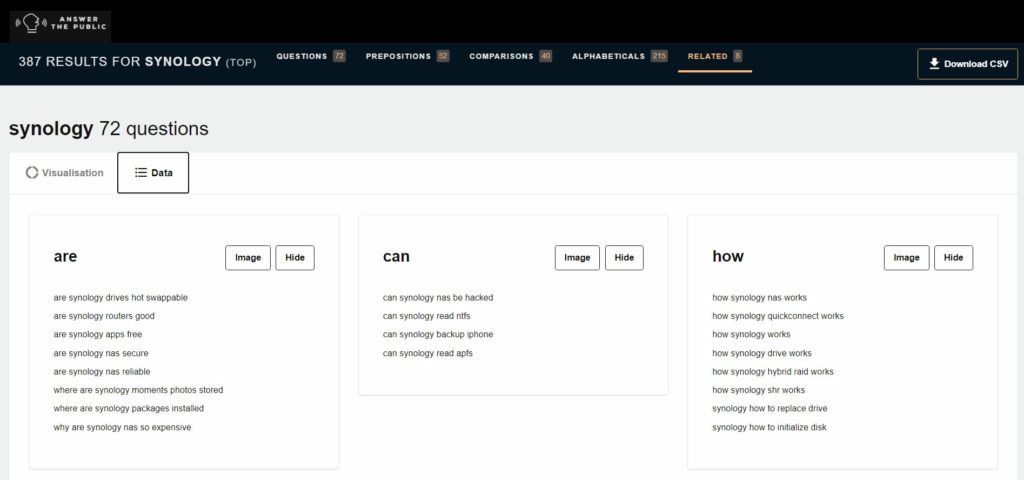
Answer The Public Features
- Data visualization
- Downloadable results
- Good intent matching
If you’re new to keyword research and wondering where to get started, this is the tool you want to consider. Answer the Public is extremely easy to use; all you need to do is input the keywords of interest.
It is outstanding that it separates query results into intent-matching data categories with suggested keyphrases under each. While Answer the Public is by no means the most comprehensive around, it’s a strong starting point.
Answer the Public is another strong example of how SEO demands need to meet new Google associative rules. The Pro version offers unlimited queries, data comparison, listening alerts, and allows more users to access the data.
Price: Free / Pro for $99 per month.
3. SEO Minion and Google Search
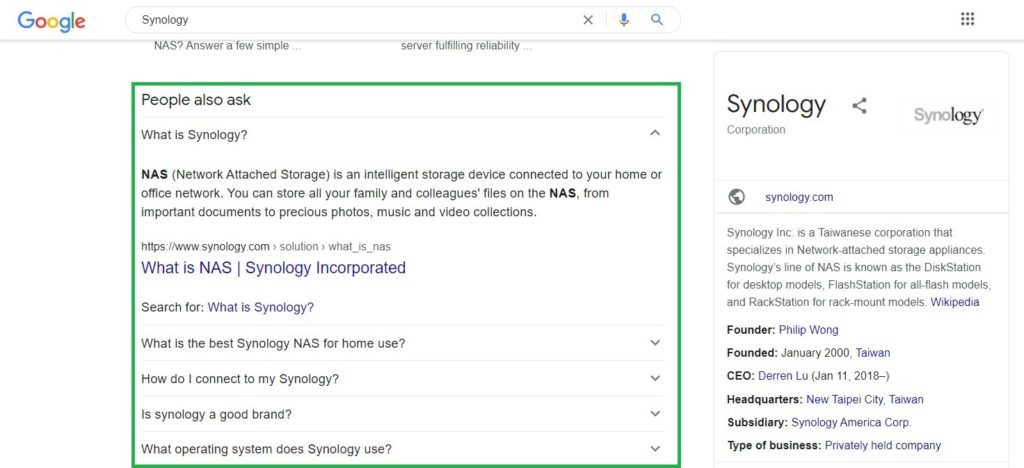
Google Search and SEO Minion Features
- Automated intent suggestions (Google Search)
- On-Page SEO analysis (SEO Minion)
- People Also Ask scraper (SEO Minion)
You may not realize it, but Google Search provides some helpful information as well. Try it out for yourself – just run any search query. Look at the search results, and you’ll notice a section called “People also ask” with some questions and matching answers (if you click on them.”
This section is google’s way of trying to meet search intent, so it’s essentially already done the work for you. The list of search results under that is the best of what Google can find that meets your query, and this can be helpful if you use SEO Minion.
SEO minion is a free Chrome extension that lets you example pages for various elements like headers, links, and more. Using SEO minion and the top 10 search results from Google will give you a firm idea of what to cover for the keyword you want.
Price: Free.
4. Ahrefs Keyword Research

Ahrefs Features
- Location-based results
- Shows search volume and value
- Indicated keyword difficulty
Ahrefs is a potent and comprehensive SEO tool. While most features require their paid service, they offer a free keyword utility that is good for location-based queries. Take, for instance, the exact three keywords we’ve been using.
The result that comes out shows actual numbers based on current search volumes. You can select the region and search engine data you want to establish the results upon (e.g., Google, Bing, Yahoo).
Ahrefs is pretty limited, though, unless you’re willing to pay for a subscription. If you do, it’s a whole new can of worms, and you likely won’t need anything else. Still, free is a great place to get started.
Price: Free / Paid subscriptions start from $99 per month.
Keyword Roundup
Using the correct keywords is one of the most important pillars of your SEO master plan. Thankfully, you can meet this need by using the right tools, especially those leveraging heavily on native Google data.
Aside from the keywords you discover, it is equally important to look at the content from a bird’s eye view.
There is also a need to make use of the correct associative words. This association can be tricky since it isn’t as simple as putting forth synonyms or repetitions at strategic locations within the text.
3. Backlinks
No website on the Internet is an island – or at least no successful website is one. If you’ve heard of the term “guilt by association,” then you’ll understand how this works. Search engines often use backlinks to give them a good idea of the quality of a site or content page.
What are Backlinks?
Backlinks are hyperlinks that point one page towards another. They are an essential element for search engines to see how authoritative your content is. The more backlinks you have, the higher the chance that search engines will see you as having good content.
Aside from quantity, the quality of backlinks is also important. Google ranks all websites on the Internet, and the way they associate with each other is also a contributor to search ranking. One reputable, high-ranking site linking to your content is more valuable than links from ten low-rank websites.
Think of the backlink as a vote from the websites that refer to your content.
Evolution of Backlink Interpretation
Over the years, the Google algorithm has evolved in reaction to changing trends in technology and human behavior. These changes have sometimes resulted in a significant impact on website traffic.
Unfortunately, the changes are seldom positive for website owners who have focused heavily on “unusual” link-building strategies.
Enter the Google Penguin
Before we discuss Google Penguin, it is essential to understand that these names refer to updates to the algorithm – they aren’t entire replacements that always supersede previous concepts. For example, the Mobile update of 2015 was to address the increasing number of Internet-connected mobile devices.
Google’s first major algorithm evolution was Panda which focused on penalizing websites for content-based infractions. Barely more than a year following that, in April 2012, Google Penguin was introduced. Penguin was an algorithm update that deeply impacted many websites.
Focus on Backlink Quality over Quantity
The key focus of Google Penguin was removing the tons of low-quality backlinks flooding the Internet.
Before Penguin, website owners were attempting to gain ranking by leveraging Google’s simple approach towards links as a source of authority. To get a better idea of how this works, you might think that all you need to get various websites in link-sharing agreements, and the entire web will be a happy place. Unfortunately, so did others, which resulted in zombie sites packed with nothing but links. It was a cheap and easy way to get better search rankings.
Penguin, also known as the webspam update, slapped down on link spammers (by Google’s definition) that brought no real benefit to visitors and possibly introduced unnecessary risk elements due to the low quality of links spammed.
Google Penguin Today
Google Penguin affected slightly more than 3% of all search queries in its initial introduction. Given that Google processes billions of queries each day, that small percentage represents a massive impact on the overall ecosystem.
Since then, Google has refined Penguin several times, releasing three other significant updates (along with a few minor ones) over the years. Each time, we could see that the number of search queries affected was reduced – but still present – reflecting slight modifications in concept over time.
“Real Time” Update to Penguin
Today Google Penguin is in its fourth iteration (Penguin 4.0) and has been relatively stable since 2016. The most critical aspect of Penguin 4.0 was the “Real Time” update that accompanied it. This addition meant that web pages would be subject to “spot checks” to see if they included unnatural links in the mix.
As a whole, Google Penguin has evolved to become much more circumspect. It’s clever enough to know that one bad apple doesn’t necessarily spoil; the whole barrel. This concept brings both advantages and disadvantages to website owners.
The main advantage of Real Time Google Penguin is that having a bad link somewhere on your site doesn’t mean the entire website gets tarred and feathered. Instead, the offending page will get buried, never to see the light of day – unless it gets “fixed.”
Yet, the same advantage is also a slight problem since one or two poorly performing web pages can easily go unnoticed amidst a massive number of other pages that are fine. Unless website owners could accept “occasional losses,” they needed to carry out comprehensive reviews of existing content to remove possible “bad links” that might tank their position on SERPs.
Real Time Google Penguin also brought increased risk to websites that used user-generated content since they could bring in bad links at any time.
SEO Implications of Backlinks
While the algorithm continues to get updates, there is no doubt that quality is now a significant factor in using backlinks to indicate quality. Website owners need to focus on organic backlink building that offers real value to potential site visitors.
Organic Backlink Building 101
Building backlinks holistically isn’t precisely challenging, but it can be pretty time-consuming. Website owners need to focus on the needs of their users and link content in a way that supports the needs of their visitors and improves page content.
Some ways of getting solid backlinks include;
- Become a source. You can work toward this by compiling lists of helpful information, including statistics, events, collections, and more. Conducting studies or simply collating information can quickly fulfill this requirement. One example of this is HostScore’s compilation of web hosting industry statistics and data that have earned them hundreds of natural backlinks.
- Create shareable content. Not forgetting the aspect of social indicators, backlinks also work for social media sites in some way. To address this, create content bites such as infographics, videos, or even memes that users can easily share on these platforms. The Vox Video Page attracted over 5,000 high-quality links – including those from the NY Times, Forbes, Yahoo!, TheVerge, and more.
- Building useful tools for users will encourage that to use them and share the capabilities with others. WebPageTest, for instance, has seen increased usage thanks to new Google speed guidelines.
- Crafting quality content helps to attract links naturally. Building authority doesn’t necessarily mean long, dry content. You can also improve your backlink profile by having unique quirks, presenting information differently, or standing out in other ways.
- Guest posting not only helps you build backlinks but allows you to more incisively choose the platforms you want associating with your brand or content.
- Getting interviewed is an excellent way to generate more natural backlinks from sites that may be highly authoritative—for instance, national or worldwide news media coverage.
In most of these examples, we can see that the core purpose to meet is offering value. If you aren’t careful about what backlinks you introduce, the result could be a worse performance on SERPs than intended.
As long as you build content that is of use to people, there is little chance that naturally earned external backlinks will be an issue.
Backlink Roundup
As you can see from these suggestions, the means of getting healthy backlinks involves real work and is a far cry from simple link exchanges. The resulting behavior is to naturally force website owners to consider which backlinks to pursue carefully.
Not only do your backlinks serve as an indicator of authority, but they also serve to give Google deeper insight into the nature of the content it’s pursuing.
Each enhancement of Google’s Penguin update has refined requirements, and the latest ones offer advantages and disadvantages. It has shifted from a rigid “one-time fix” solution towards a need for constant monitoring to ensure that bad links don’t suddenly appear again.
The good news is that if they do get discovered by Google, you don’t suffer the same death penalty for the entire site as before – simply correct the offending page.
Conclusion
SEO is an evolutionary art and one which has seen much change even over the past decade. The changes that Google makes to its algorithm can easily make or break a website. This fact is especially true for those that focus too keenly on simply ticking the right boxes.
From a strategic viewpoint, those who place importance on SEO must recognize the true intent behind search algorithm changes – to deliver accurate and valuable results. Tempering SEO with common sense can go a long way to developing a formidable SEO strategy that will withstand the test of time.
Frequently Asked Questions
Is SEO necessary?
Yes, it is. SEO is the best and most powerful means of building organic traffic to your website. Failing to meet SEO needs can result in low search rankings, and most results past the first SERP aren’t likely to generate much visitor volume. While there are other means of traffic generation, none are as wholesome or sustainable.
Is SEO still relevant in 2021?
SEO remains one of the most vital aspects of website traffic building, and its importance is only increasing. Unless new means of holistic visitor attraction become available, SEO will continue to be relevant in the future.
How will SEO change in 2021?
Based on changing technology and needs, SEO has already evolved significantly over the years. Relatively newer adaptations have put semantics and website performance in the spotlight. However, the overall objective will always be to meet the needs of search queries accurately.
How do you create an effective SEO strategy?
Crafting a reliable SEO strategy requires a deep understanding of SEO algorithms and the concepts behind them. As a general guideline, you need to deliver well-structured and comprehensive information in a neat package.
Is Local SEO dead?
Despite some opinions to the contrary, local SEO is not dead. It has, however, evolved to some extent. Local SEO now looks more closely towards indicators with a broader focus, such as social indicators of trust.
Is SEO worth the money?
SEO is worth the money. Since SEO builds traffic organically, the value simply blows away other methods such as paid advertising or marketing campaigns. By integrating SEO principles into content, you’re ensuring a long, steady flow of traffic without continuous unsustainable investment.

